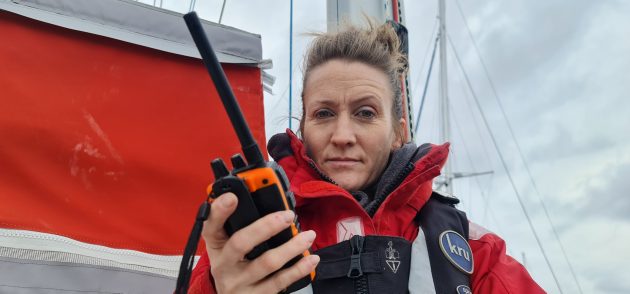Communications Specialist and Tech Editor Fox Morgan answers some of your top questions regarding what to look for in a handheld VHF marine radio.
Your burning questions answered about Handheld VHF marine radios
Unless you eat sleep and breath all things marine communications and safety like I do, then you might be correct in saying there’s better things to do with your time than scrolling through endless specification sheets and trawling the internet for information, that you might not even know that you don’t know.
I’ll give you a bit of a hand then with this simple guide and answer some of the top questions regarding the best handheld VHF radio for marine use and what you need to know when choosing one or using one.
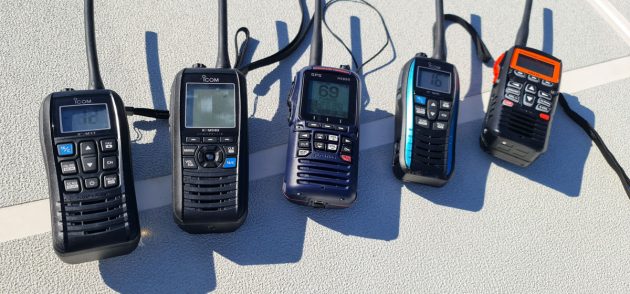
What kind of Range can I expect from my handheld VHF radio?
The range of your handheld depends on two main factors: 1 -The height of your antenna above sea level and 2 – the power setting.
As a line of sight type of radio signal, the antenna signal will travel up to 10 miles if the antenna is 1 or 2 metres above sea level, ie when you are standing in the cockpit of an average boat transmitting to another boat receiving you on a mast head antenna (see boat A communicating with B in my stunning hand drawn diagram) If both boats A and B are using handhelds only though, they will struggle with the range as they are both transmitting and receiving on only 6w power and low to the sea level.
If you are in a liferaft, sitting on the surface of the sea calling out a mayday, then your signal won’t go very far. We can see that if boats A and B are roughly 10 miles apart, They can both communicate with a liferaft between them, but for boat A to C, that communication will be at it’s limit at just 4 or 5 miles.
This distance will be reduced if you have a big sea state or if you have any rocky bits or land in the way, as they can all cause a signal shadow that blocks the VHF radio signal.
You can use a VHF handheld marine radio anywhere at sea, from a harbour to the middle of an ocean. The main thing is that you are within range of someone else with a VHF receiver.
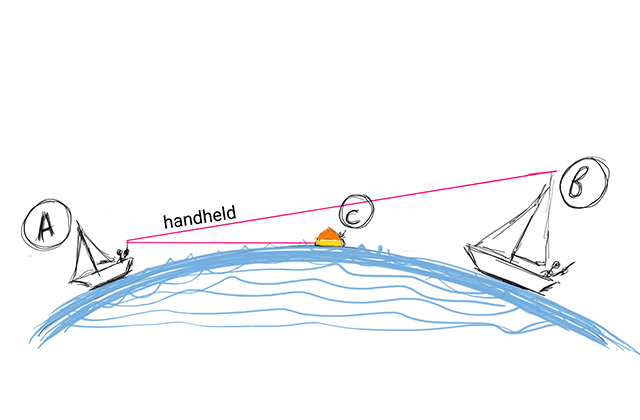
What do the power settings mean on my handheld VHF marine radio?
When we transmit on channel 16, the internationally reconised channel for listening and distress communication, then most of the modern sets, handheld or fixed will automatically switch to maximum power, which for consumer sets like ours is 25w for a fixed set with a masthead antenna and 6w for a handheld VHF marine radio.
When switched to ship to ship channels such as ch06 then the power is often automatically reduced to 1w. This allows more localised vessels to communicate without interference from one another, but it will reduce the signal range dramatically to roughly 4-5 miles ( at 2m above sea level). Which is absolutely fine if you are talking to a ship you can see at night or other yacht in your vicinity.
On some channels, such as 15 and 17, the power is restricted to 1w. These channels are for use between two radios on the same vessel.
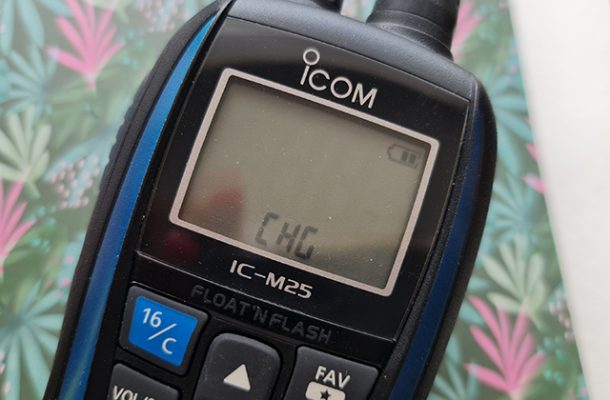
What kind of Battery life can I expect from a handheld VHF?
Listening on your handheld VHF uses very little power and battery life can be days long. Transmitting will zap the battery life, especially when on full power. In my tests for a range of handheld radios, standby listening battery life varied from 20hrs to over 3 days. Once you start talking though, those battery times drop to roughly half that.
A charging cradle is common in most top end vhf handhelds, these can be wall mounted and located with a dedicated power supply from a 12v or mains power outlet. Other models are changed with USB plugged directly into the unit via a waterproof flap.
Cradles are my personal preference as handheld radios get wet and with a quick wipe can be clicked safely into a charging cradle as the charge points are external. The USB plug in, or other style of plug into the unit can be susceptible to water ingress and faulty charging, but they are easier to charge from a portable power station or external battery pack.
Some units come with a replacement battery back that accepts disposable batteries, usually AA or AAA batteries. These are handy for stashing in a grab bag allowing an extension to the battery life when recharging isn’t an option in an emergency situation. Emergencies come in all shapes and sizes: If your vessel is struck with lightning, then you might have to rely on a handheld radio for comms and one with an ability to be powered away from the vessels main power system is very useful.
What does squelch do?
Radio signals come with a certain amount of extraneous wave length noise and to cancel this out we use squelch to reduce the spikes on the radio signal. Too little squelch and you’ll have a lot of white noise, too much squelch and you’ll cut out the actual transmission from being heard. Most radios have a sweet spot for most radio transmissions and once you’ve set it, it’ll move very little up or down, just occasionally tweaking it for best audio results and clarity.
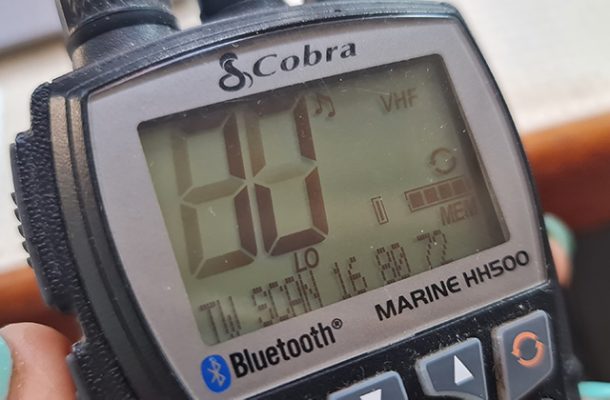
Why do I need Dual or Tri watch scanning?
We should maintain a listening ear on channel 16 at all times, but often if we are in an organised fleet or event, there will be an agreed channel to communicate on. So it ‘s quite normal to keep a listen on an additional channel. Equally you might be in a busy shipping area and you want to keep an ear on the shipping movements going on around you, so you might have that, often channel 12 as well as 16 on dual watch.
If you are in a busy shipping area and you are also in a fleet, you might listen to three channels, ch16, local vessel movements ch12, and your agreed 3rd channel for vessel to vessel to within fleet comms. This might be channel 69 or similar.
Do you need a licence for a vhf?
In the UK, all vhf transmitters require a licence from Ofcom. In the United States, you may require a licence from FCC, but for recreational use only a licence is not mandatory within the United States region. But if you are sailing into other territories, then check the local regulations and how they apply to you.
If your handheld VHF has DSC capability then you will also need to program it with your MMSI number, also obtained from Ofcom or FCC.
Failure to obtain a licence and subsequent unlicenced operation of a radio where one is required will be met with a fine.
You may be asked for your call sign when in communication with a harbour authority. Unlicenced operators don’t have one.
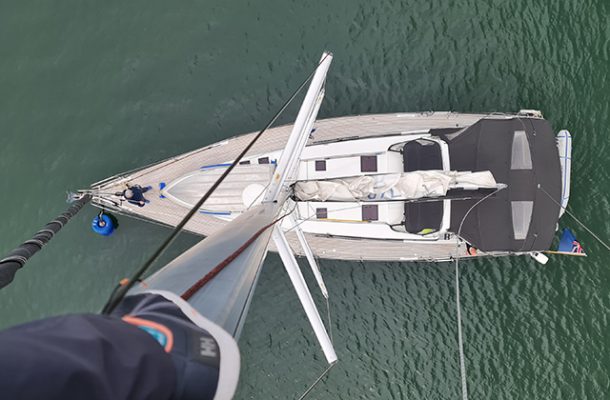
Can I use my VHF handheld for communication with someone on the same boat?
There’s sometimes a requirement to communicate with someone from your own boat either from a small tender or from up a mast. This is where two or more handheld VHF radios can be useful.
This might be because someone has to go out and set an anchor from a dinghy if you have run aground or head up the mast to fix something whilst underway. In port we often can use a mobile phone on handsfree or with a headset, but at sea this isn’t an option. Being able to communicate easily with those on deck or operating a winch to control your movement up or down the mast can be critical in avoiding injury. You might consider opting for voice activated headsets instead of using VHF handhelds. But if you do use VHF for this purpose onboard, you’ll be using ch15 or ch17 which is restricted to just 1w of power.
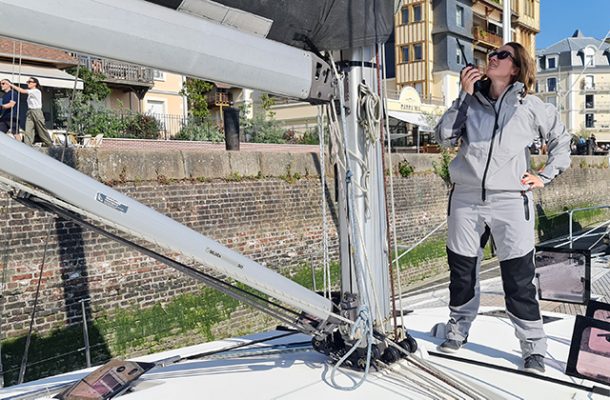
A handy guide to VHF channels and their uses
| Channel |
United Kingdom | United States | |
| 0 | Private, coast guard A | ||
| 1 | Ship-to-ship/shore, commercial and safety West Coast A |
||
| 2 | |||
| 3 | A Illegal for public use | ||
| 4 | |||
| 5 | |||
| 6 | Ship-to-ship and ship-to-air A | ||
| 7 | |||
| 8 | Ship-to-ship A | ||
| 9 | Frequently used by pilots A | Calling A , commercial and non-commercial. | |
| 10 | Frequently used by HM Coastguard A | ||
| 11 | Port operations | ||
| 12 | Port operations | VTS – San Francisco offshore Pilotage A |
|
| 13 | Bridge-to-bridge working A | Bridge-to-bridge safety A : Vessels > 20m must maintain watch, Tx limited to 1 watt. Movable bridge / lock operations. | |
| 14 | Port operations | VTS – San Francisco bay and delta Pilotage A |
|
| 15 | A On-board working, limited to 1 watt | ||
| 16 | International Maritime distress, listening and calling channel | ||
| 17 | A On-board working, limited to 1 watt | ||
| 18 | |||
| 19 | Landside facilities: harbormaster, marinas. | ||
| 20 | |||
| 21 | A U.S. Coast Guard only | ||
| 22 | A U.S. Coast Guard public working channel | ||
| 23 | HM Coastguard Maritime Safety Information: now on 62, 63, 64. | A U.S. Coast Guard Only | |
| 24 | UKSAR Ground to air Winching A UKSAR Two Way channel B |
||
| 25 | |||
| 26 | HM Coastguard Maritime Safety Information | Public correspondence (marine telephone operator) | |
| 27 | |||
| 28 | |||
| 31 | |||
| M1/37A | (As M1) Yacht clubs, race committees and marinas | ||
| 60 | |||
| 61 | A Illegal for public use | ||
| 62 | HM Coastguard Maritime Safety Information | ||
| 63 | HM Coastguard Maritime Safety Information (half-duplex) | ||
| 64 | HM Coastguard Maritime Safety Information (half-duplex) | A Illegal for public use | |
| 65 | National Coastwatch Institution (NCI) and Independent Coastwatch Stations (http://www.seasafetygroup.org) Working Channel for communication with local mariners for radio checks and local sea conditions. | ||
| 66 | |||
| 67 | UK Small Ship Safety Channel | ||
| 68 | Non-commercial A | ||
| 69 | Port operations | Non-commercial A | |
| 70 | No voice calls : Digital Selective calling channel – used for distress calls via DSC | ||
| 71 | Port operations | Non-commercial A | |
| 72 | Ship-to-ship A Frequently used by leisure craft | Non-commercial ship-to-ship A | |
| 73 | HM Coastguard Safety Broadcasts
Backup Small Ship Safety |
||
| 74 | British Waterways/Canal and River Trust Channel (Canal and River System)
port operations |
||
| 75 | Navigation related communications, limited to 1 watt | ||
| 76 | |||
| 77 | Ship-to-ship A | ||
| 78 | Non-commercial A | ||
| 79 | |||
| 80 | UK marina channel | ||
| 81 | A U.S. Government Use Only | ||
| 82 | A U.S. Government use only | ||
| 83 | A U.S. Coast Guard use only | ||
| 84 | HM Coastguard Maritime Safety Information: now on 62, 63, 64. | ||
| 85 | UKSAR TWC (half-duplex) | ||
| 86 | HM Coastguard Maritime Safety Information: now on 62, 63, 64. | ||
| 87 | |||
| 88 | |||
| M2/P4 | (As M2) Yacht clubs, race committees and marinas |




